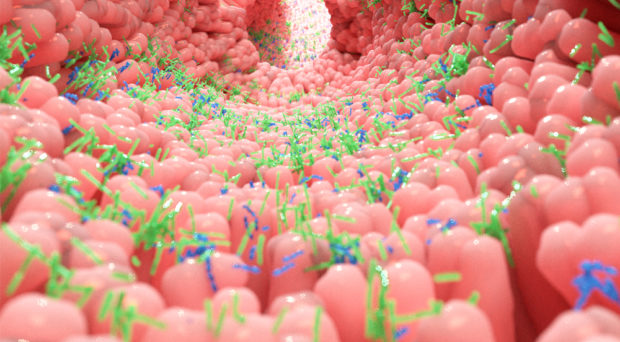
Combination antiretroviral therapy (cART) has dramatically changed the course of Human Immunodeficiency Virus (HIV) infection, by suppressing the viral load in the peripheral blood and reconstituting the CD4+ T-cell (immune cells) compartment. This has brought a significant reduction in HIV-associated mortality and an increase in life expectancy for cART-treated HIV+ patients, that is now approaching that of HIV-negative individuals.
Despite these findings, cART is not able to correct the immune imbalances which are a feature of HIV infection: specifically, high levels of T-cell activation persist in patients successfully treated with cART. This puts them at increased risk of non-infectious comorbidities, premature aging and death.
Why is the study of the gastrointestinal tract important in HIV Infection?
The continuous passage of bacteria and microbial bioproducts from the gut lumen to the systemic circulation (so called microbial translocation) has been proven to be one of the leading causes of heightened inflammation and immune activation in HIV+ patients, which in turn has been linked to the pathogenesis of several degenerative clinical conditions such as atherosclerosis, osteoporosis and neurocognitive impairment. All these conditions have been shown to be very prevalent in cohorts of well-treated HIV+ individuals.
A solid bulk of literature has invariably shown that a major cause of microbial translocation HIV-infected, cART-treated subjects is the reduced expression of the proteins forming the gut junctional complex.
Anatomical defects of the gut epithelial barrier are not the sole causes of microbial translocation. Studies have shown that the degree of gastrointestinal damage may not precisely mirror that of gut leakage, thus suggesting that other factors may contribute to intestinal permeability. In this respect, HIV infection features the depletion of mucosal immune populations which safeguard the intestinal mucosa, in particular subsets producing IL-17 – a protein involved in the inflammatory response.
Numerical and functional impairment of these cells also occurs in viro-suppressed individuals, thus allowing for microbial translocation in the course of treatment. Further, recent evidence from our group presented at the Conference on Retroviruses and Opportunistic Infections (CROI) held in Boston, US in March 2018, has shown depletion of gdT-cells, which are a major source of IL-17, both in the peripheral blood and mucosal sites in chronically-infected individuals.
Taken together, these findings point to the gastrointestinal tract as a major site of HIV pathogenesis
Our data, together with recent literature evidence in mouse models demonstrating that gd T-cells promote epithelial barrier function may explain the reduced expression of gut junctional complex proteins in treated HIV infection because of low IL-17 production in gd T-cells.
Impairment of the mucosal barrier and immunity in chronic HIV infection may be also linked to dysbiosis (microbial imbalance) of the gastrointestinal tract. HIV-infected individuals feature the enrichment for Proteobacteria and skewing of the Bacteroidetes phylum with a Prevotella-rich/Bacteroides-poor profile which associates with both peripheral blood and mucosa immune defects.
In line with the findings on the persistent impairment of gut structure and mucosal immune population in the course of cART, HIV-related dysbiosis is not corrected by the introduction of therapy. From a pathogenic standpoint, Prevotella species have pro-inflammatory properties which may fuel intestinal damage and mucosal immune skewing, thus allowing for microbial translocation to occur in HIV infection and endure in the course of suppressive treatment.
Taken together, these findings point to the gastrointestinal tract as a major site of HIV pathogenesis; as such, the gut needs to be targeted for the elaboration of novel therapeutic interventions and seek for an HIV cure.
In this review we focus on the major features of gut damage in the course of HIV infection. In particular, we review recent data supporting the predictive role of microbial translocation in HIV-related morbidity and mortality, the mechanisms by which it arises and potential therapeutic approaches.
Comments